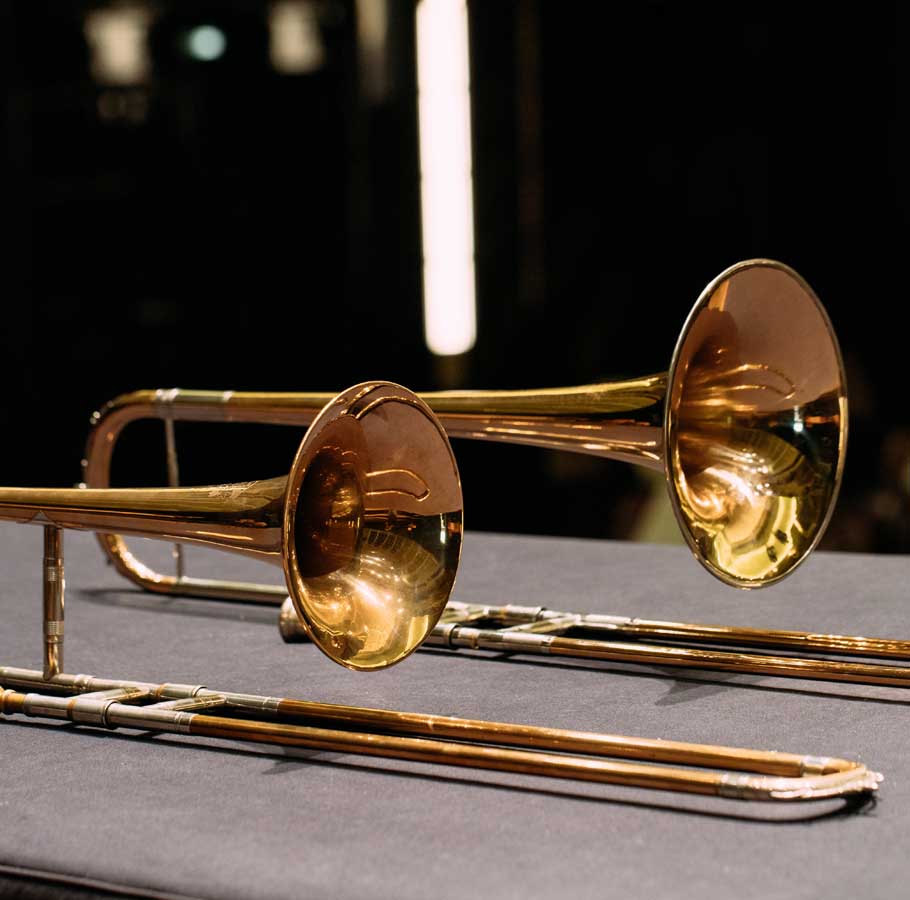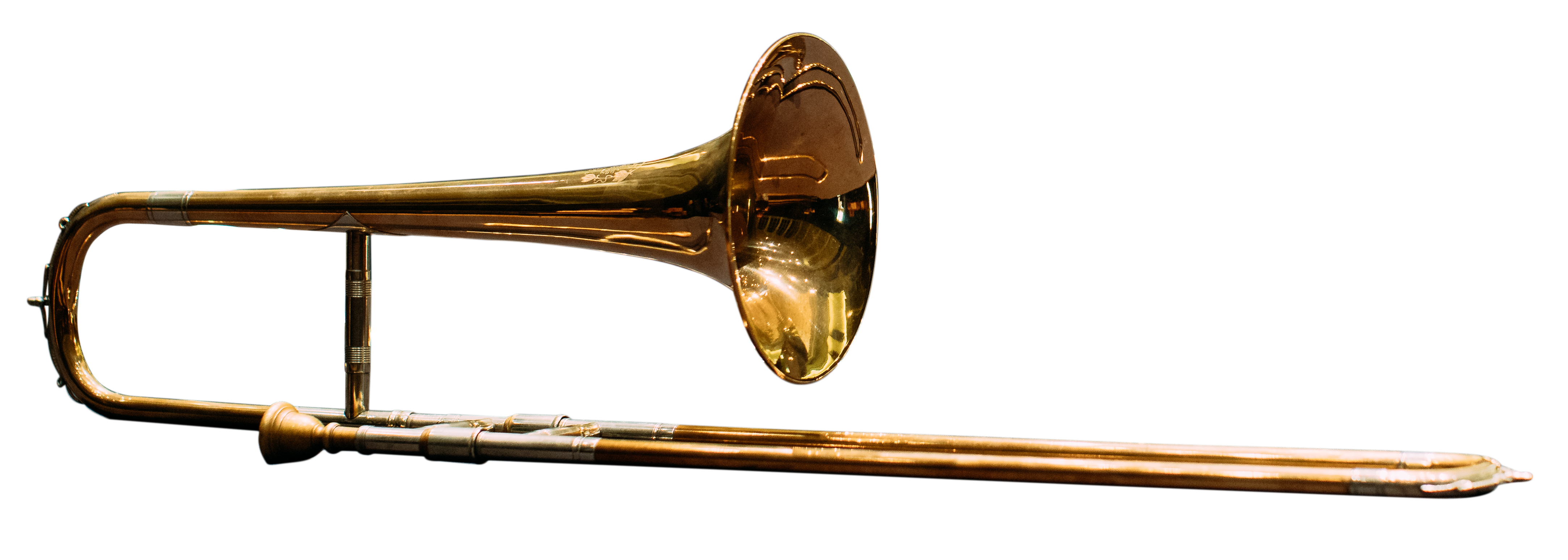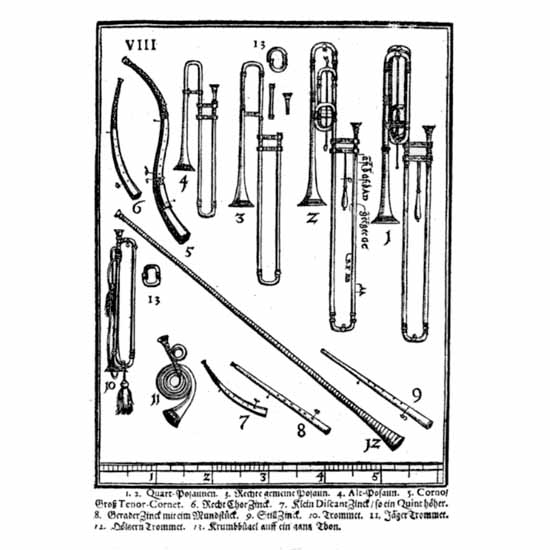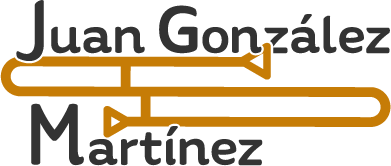
Historical trombones
Drewelwecz trombone
Built in 1595 by Anton Drewelwecz, this tenor trombone is considered a typical historical trombone of the period or a right common trombone as mentioned by Michael Praetorius in Syntagma Musicum vol. 2 (1620) (see below). On January 12, 1865, the General Secretary of Kürfurst-Friedrich-Wilhelms-Nordbah acquired it in Kassel. After more than 400 years, the original instrument, which has been very little altered, is now in the Germanisches Nationalmuseum in Nuremberg under the shelfmark MI167.

Starck trombone
Hieronimus Starck (1640 - 1693) built this alto trombone in Nuremberg in 1670, four years after obtaining his master's license. The original instrument is in the Germanisches Nationalmuseum, Nuremberg, under inventory number MI173.

Blacksmith trombone
Johann Joseph Schmied (1722-1797) belongs to the third generation of a family of brass instrument makers based in Pfaffendorf (near Lauban in Silesia, now Rudzica) between the 17th and early 19th centuries. The original alto trombone built in Pfaffendorf in 1785 is in the Basel Historical Museum under inventory number 1980.2121.

Eschenach trombone
The son of the carpenter and string maker Johann Gottfried Eschenbach (1698-1781) Johann Georg Eschenbach (1740-1797) from Markneukirchen founded the guild of wind instrument makers there. In 1796 he built, among other instruments, a tenor trombone in a' = 432 Hz, which is now in the Musical Instrument Museum of the University of Leipzig with catalog number 1899. Another tenor trombone by Johann Georg Eschenbach is in the Germanisches National Museum in Nuremberg under the signature MIR 143, which is signed (17)69.

Uhlmann trombone
The original instrument is signed "Leopold Uhlmann, k.k.priv. Instrumenten Fabrik in Wien" and "k.k.. Hofkapelle". It is unfortunately undated, but must have been made by Leopold Uhlmann (1806-1878) in 1840. This historic trombone is privately owned.
An identical instrument by Leopold Uhlmann, but without a neusilver set, is in the Kunsthistorisches Museum in Vienna. This instrument is a complete slide trombone that was formerly in the collection of the Gesellschaft der Musikfreunde Vienna. Leopold Uhlmann thus built a particularly beautiful and high quality instrument for the Imperial and Royal Court Chapel shortly after his privileging.(Thanks to Benhard Meinl for the information)

Kuhn trombone
Pupils of the court instrument maker in Elberfeld Leopold Mitsching (1865-1922) Franz Kuhn (?-1955) worked in his workshop and together with the trombone virtuoso Serafin Alschausky (1879-1948) conceived a trombone model of German Romantic design. It quickly spread throughout Germany. This model was further developed by Kuhn and is still handmade today in Bremen by the brass instrument making company Herbert Lätzsch as the "Kuhn model". The Franz Kuhn Trombone Quartet plays an original 1920/30s Kuhn trombone set (ATBB).

Drewelwecz trombone
Built in 1595 by Anton Drewelwecz, this tenor trombone is considered a typical historical trombone of the period or a right common trombone as mentioned by Michael Praetorius in Syntagma Musicum vol. 2 (1620) (see below). On January 12, 1865, the General Secretary of Kürfurst-Friedrich-Wilhelms-Nordbah acquired it in Kassel. After more than 400 years, the original instrument, which has been very little altered, is now in the Germanisches Nationalmuseum in Nuremberg under the shelfmark MI167.



Starck trombone
Hieronimus Starck (1640 - 1693) built this alto trombone in Nuremberg in 1670, four years after obtaining his master's license. The original instrument is in the Germanisches Nationalmuseum, Nuremberg, under inventory number MI173.
Drewelwecz trombone
Built in 1595 by Anton Drewelwecz, this tenor trombone is considered a typical historical trombone of the period or a right common trombone as mentioned by Michael Praetorius in Syntagma Musicum vol. 2 (1620) (see below). On January 12, 1865, the General Secretary of Kürfurst-Friedrich-Wilhelms-Nordbah acquired it in Kassel. After more than 400 years, the original instrument, which has been very little altered, is now in the Germanisches Nationalmuseum in Nuremberg under the shelfmark MI167.


Blacksmith trombone
Johann Joseph Schmied (1722-1797) belongs to the third generation of a family of brass instrument makers based in Pfaffendorf (near Lauban in Silesia, now Rudzica) between the 17th and early 19th centuries. The original alto trombone built in Pfaffendorf in 1785 is in the Basel Historical Museum under inventory number 1980.2121.


Eschenach trombone
The son of the carpenter and string maker Johann Gottfried Eschenbach (1698-1781) Johann Georg Eschenbach (1740-1797) from Markneukirchen founded the guild of wind instrument makers there. In 1796 he built, among other instruments, a tenor trombone in a' = 432 Hz, which is now in the Musical Instrument Museum of the University of Leipzig with catalog number 1899. Another tenor trombone by Johann Georg Eschenbach is in the Germanisches National Museum in Nuremberg under the signature MIR 143, which is signed (17)69.
Uhlmann trombone
The original instrument is signed "Leopold Uhlmann, k.k.priv. Instrumenten Fabrik in Wien" and "k.k.. Hofkapelle". It is unfortunately undated, but must have been made by Leopold Uhlmann (1806-1878) in 1840. This historic trombone is privately owned.
An identical instrument by Leopold Uhlmann, but without a neusilver set, is in the Kunsthistorisches Museum in Vienna. This instrument is a complete slide trombone that was formerly in the collection of the Gesellschaft der Musikfreunde Vienna. Leopold Uhlmann thus built a particularly beautiful and high quality instrument for the Imperial and Royal Court Chapel shortly after his privileging.(Thanks to Benhard Meinl for the information)


Kuhn trombone
Pupils of the court instrument maker in Elberfeld Leopold Mitsching (1865-1922) Franz Kuhn (?-1955) worked in his workshop and together with the trombone virtuoso Serafin Alschausky (1879-1948) conceived a trombone model of German Romantic design. It quickly spread throughout Germany. This model was further developed by Kuhn and is still handmade today in Bremen by the brass instrument making company Herbert Lätzsch as the "Kuhn model". The Franz Kuhn Trombone Quartet plays an original 1920/30s Kuhn trombone set (ATBB).

